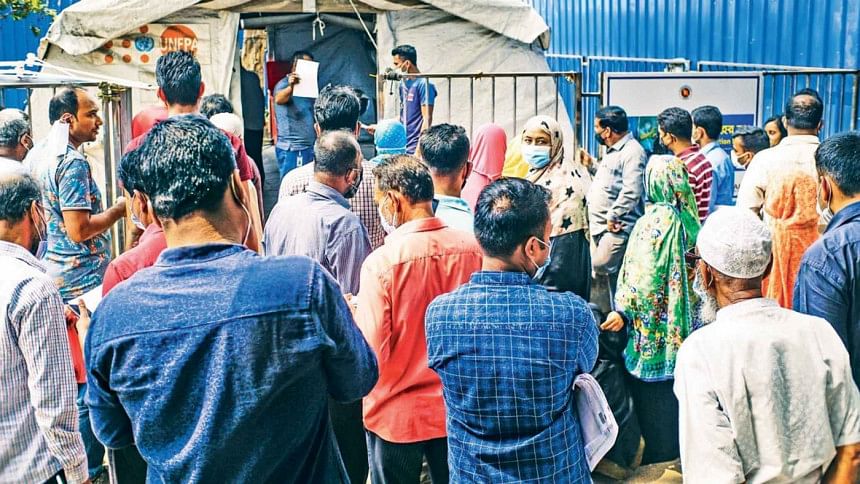Single-dose Oxford vaccine cannot protect against Indian variant

Bangladesh is potentially approaching a dual crisis. One is the shortage of the Oxford-AstraZeneca vaccine, Covishield, leaving over 14 lakh people in uncertainty over their second doses, and the other is the emergence of the notorious "Indian variant" in the country.
Initially, there was a glimmer of hope that people who received the first dose of Covishield will be protected from Covid-19 at least for three months or so—and therefore, they can wait for longer to get their second dose, when it is available, to achieve a fuller protection.
Previously, the Phase-3 clinical trial data showed that a single dose of Oxford vaccine can protect 76 out of 100 vaccinated people (76 percent efficacy) from symptomatic Covid by the non-mutated original version of coronavirus. This finding was later supported by "real world evidence" demonstrated by the Public Health England in their post-vaccine surveillance study amongst older people, published in the BMJ on May 13, 2021, which showed that a single dose of either Oxford-AstraZeneca or Pfizer vaccine provides at least 60 percent protection from symptomatic Covid and over 80 percent protection from severe Covid and death from the mutated "UK variant" (B.1.1.7) virus infection.
This data lets the policymakers in Bangladesh advise delaying for second dose beyond the WHO-recommended 12-week timeframe. The government appears optimistic about arranging the required Oxford-AstraZeneca shots from sources other than the Serum Institute of India within a couple of months to resolve the situation.
However, a recent study conducted by Public Health England, which has yet to be peer-reviewed, showed that a single dose of either Oxford-AstraZeneca or Pfizer vaccines is not effective at all in preventing symptomatic Covid by the "Indian variant" (B.1.617.2). To achieve 60 to 80 percent protection against infection by the Indian variant, a double dose is absolutely necessary.
This finding emphasises how important it is to conduct variant surveillance in Bangladesh to monitor the spread of Indian and other variants of concern (VOC). The course of the pandemic and the efficacy of vaccines are largely driven by the mutation of the virus. This recent development should make the policymakers rethink how to address the second-dose crisis in Bangladesh, and how to protect those who will be waiting longer for the second doses if the Indian variant becomes dominant in the country, which is very much likely to happen.
In the UK, the cases of the Indian variant are increasing rapidly. To date, over 3,400 cases of the B.1.617.2 variant have been detected, which is one thousand cases more than in the preceding week. This particular variant is a sub-type of the so-called "double-mutant" Indian variant B.1.617 that was first detected in India last December. Currently, B.1.617.2 is the most reported variant in India, and the dominant variant amongst all other foreign variants in the UK. The UK's leading scientists are expecting to see this Indian variant become the dominant variant in the UK in a few months.
The B.1.617.2 variant has two significant mutations on its Spike protein: one is on its receptor binding domain (L452R) and the other is on the furin cleavage site (P618R)—the key components of the virus for infection and spread. This simultaneous dual mutation enhances its infection and transmission capability by 40-50 percent compared to the UK variant, and thus makes it a "best fit" virus for rapid community transmission.
Between April 5 and May 16 this year, Public Health England conducted a vaccine efficacy survey using Oxford-AstraZeneca and Pfizer vaccines on 11,621 UK variant and 1,054 Indian variant (B.1.617.2) cases. The study reveals that a single dose of either Oxford-AstraZeneca or Pfizer vaccines provides only 33 percent protection against the Indian variant compared to 51 percent protection against the UK variant. On the other hand, two doses of Oxford-AstraZeneca vaccine provide 60 percent protection against the Indian variant and 66 percent against the UK variant. A similar trend was seen in case of the Pfizer vaccine as well, where its two shots show efficacy of 81 percent and 87 percent against the Indian and UK variants respectively. This data provides a clear real-world evidence that to achieve protection against the Indian variant, two shots are essential. For this, the UK government is now doubling up its vaccination drive to provide two shots to 60 percent of its population by June.
In Bangladesh, several cases of the Indian variant (B.1.617.2) have been detected during the last few weeks in the border regions and in Dhaka. Despite the so-called lockdown, pre- and post-Eid movement of people could not be stopped. We have been seeing a rise in daily cases for the last 10 days. Due to its highly transmissible nature, it is likely that the Indian variant could spread along with people's movement from one region to another.
From the UK's situation, we now know that the Indian variant has the ability to outcompete other variants like South African and Brazil variants. Once the Indian variant becomes dominant, the consequence of that could be catastrophic, as we have witnessed in India and Nepal. To avoid such a disaster, we must maximise our effort to conduct nationwide variant surveillance, either by genome sequence or by targeted RT-PCR tests, as done by Public Health England. To protect people who have received only one dose of Covishield, their second doses should be ensured within the shortest possible timeframe, unless otherwise it is confirmed that the Indian variant is not widely spread in Bangladesh. There is no doubt that a single dose of Covid vaccine is not effective against the Indian variant.
Dr Khondoker Mehedi Akram is a Senior Research Associate at the University of Sheffield, UK.

 For all latest news, follow The Daily Star's Google News channel.
For all latest news, follow The Daily Star's Google News channel. 



Comments